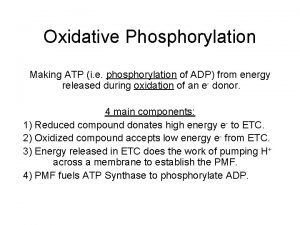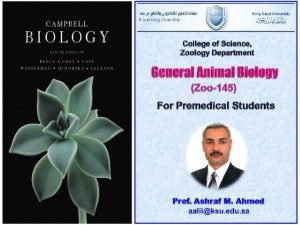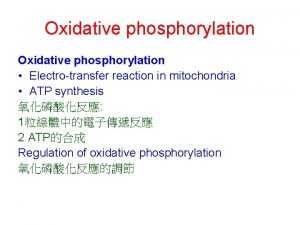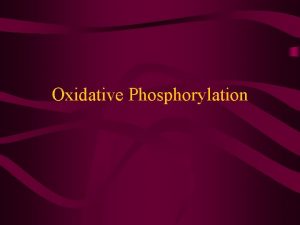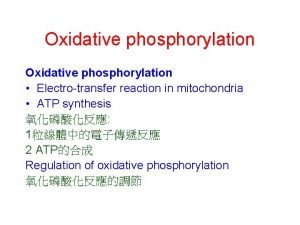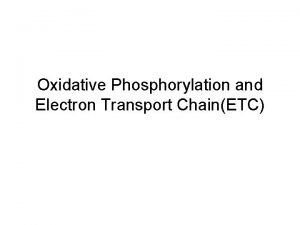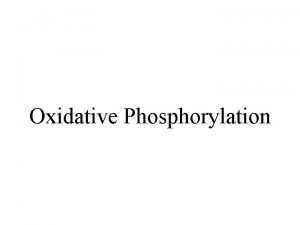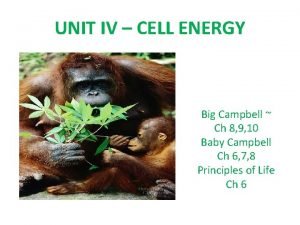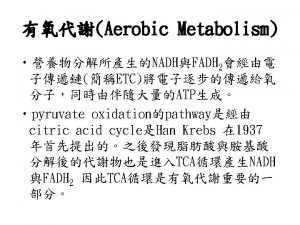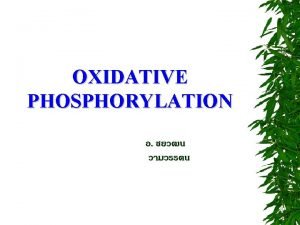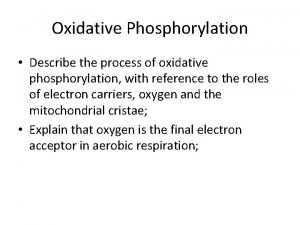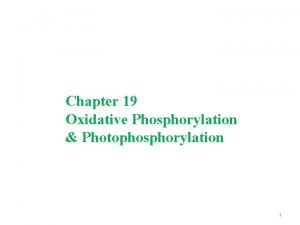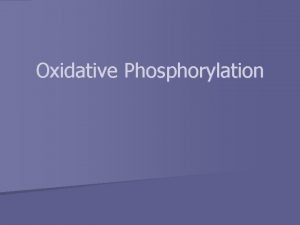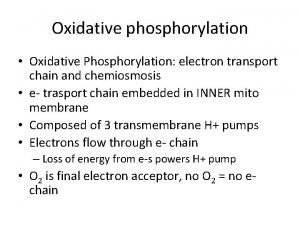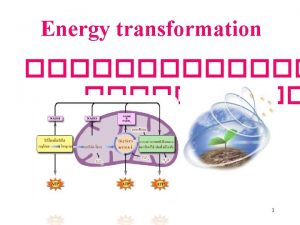Oxidative Phosphorylation Making ATP i e phosphorylation of








- Slides: 8

Oxidative Phosphorylation Making ATP (i. e. phosphorylation of ADP) from energy released during oxidation of an e- donor. 4 main components: 1) Reduced compound donates high energy e- to ETC. 2) Oxidized compound accepts low energy e- from ETC. 3) Energy released in ETC does the work of pumping H+ across a membrane to establish the PMF. 4) PMF fuels ATP Synthase to phosphorylate ADP.

Oxidation-Reduction (Redox) ΔEo’ = Change in standard reduction potential (Eo’) ΔE’o = (E’o acceptor - E’o donor) ΔGo’ = -n. F·ΔE’o Coupled ½ reactions: D + e- → DA+ + e - → A + D- = donor; More negative E’o A+ = acceptor; More positive E’o D oxidized A reduced

Spontaneous (-ΔGo’ or +ΔE’o): ½ O 2 + NADH → H 2 O + NAD+ ΔE’o = 0. 815 V – (-0. 42 V) = 1. 235 V Endergonic (+ΔGo’ or -ΔE’o): H 2 O + NADP+ → ½ O 2 + NADPH ΔE’o = -0. 42 V – 0. 815 V = -1. 235 V Better Donors Better Acceptors

Electron Transport Chains • NADH from Glycolysis (or EDP) and Krebs Cycle has a very negative E’o. • It’s electron get transferred in a cascade of membrane associate electron carriers of increasing E’o values. • E’o of the terminal electron acceptor will set the upper limit of potential energy yield. • Aerobic Respiration uses O 2 with a E’o = 0. 812 V. • Dissimilatory Nitrate Reduction* (a type of Anaerobic Respiration) uses NO 3 - with E’o=0. 42 V. (FADH 2) * NO 3 *NOTE: This specific example is for eukaryote mitochondria, which would NOT use nitrate as a terminal electron acceptor. It’s shown assuming this as a “generic” ETC of a facultative anaerobe. O 2

Chemiosmotic Hypothesis for Oxidative Phosphorylation (eukaryote mitochondria) Energy release during electron transport pumps protons across the inner membrane. A favorable proton gradient establishes from outside to inside the inner membrane (proton motive force = PMF) drives the F 1 F 0 Complex (ATP synthese) for ATP synthesis. 3 ATP per NADH; 2 ATP per FADH 2; based on P/O ratios.

Electron Transport Chain (Prokaryote) • Prokaryote ETC are structurally different and typically less efficient (lower P/O ratios) • Escherichia coli has a branched chain dependent on oxygen supply. The cyt bd branch has a P/O of 0. 67 and that for cyt bo is 1. 3 (half that for mitochondria). • E. coli yields even less ATP per glucose consumed when there is no oxygen, and anaerobic respiration is by dissimilatory nitrate reduction (nitrate to nitrite). • When nitrate is exhausted, ATP yield decreases even more as the cell solely relies on fermentation.

E. g. Parococcus denitrificans; facultative anaerobe Denitrification (nitrate to N-gases) • Nitrate Reductase like E. coli. • Further reduction of toxic nitrite • Nitric Oxide to Nitrous Oxide to N 2

Other Anaerobic Respirations
 Inhibitors of oxidative phosphorylation
Inhibitors of oxidative phosphorylation Substrate level phosphorylation vs oxidative
Substrate level phosphorylation vs oxidative Atp synthesis
Atp synthesis Define oxidative phosphorylation
Define oxidative phosphorylation Oxidative phosphorylation energy yield
Oxidative phosphorylation energy yield Uncouple oxidative phosphorylation
Uncouple oxidative phosphorylation Inhibitors of oxidative phosphorylation
Inhibitors of oxidative phosphorylation Uncouplers of oxidative phosphorylation
Uncouplers of oxidative phosphorylation Oxidative phosphorylation
Oxidative phosphorylation
